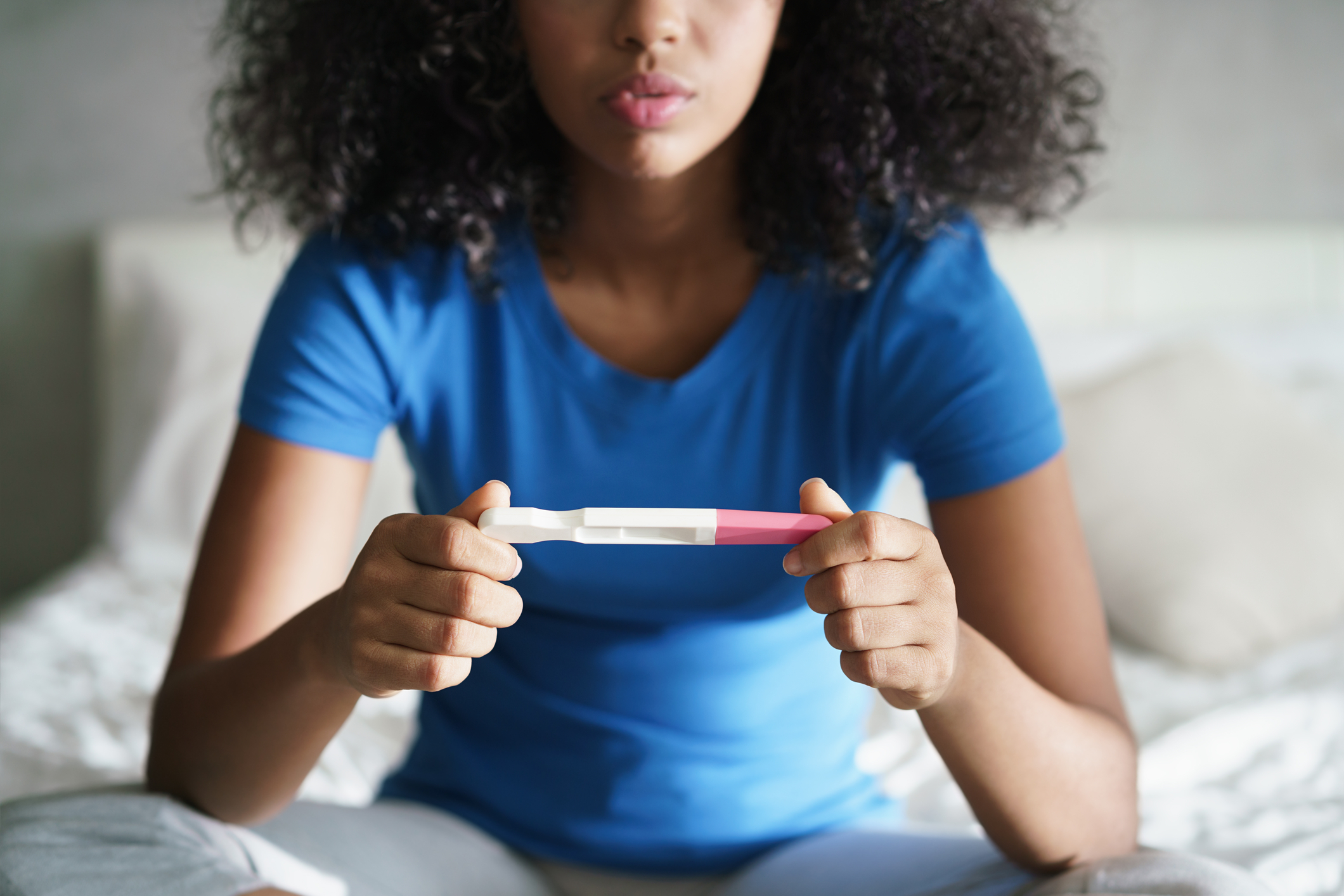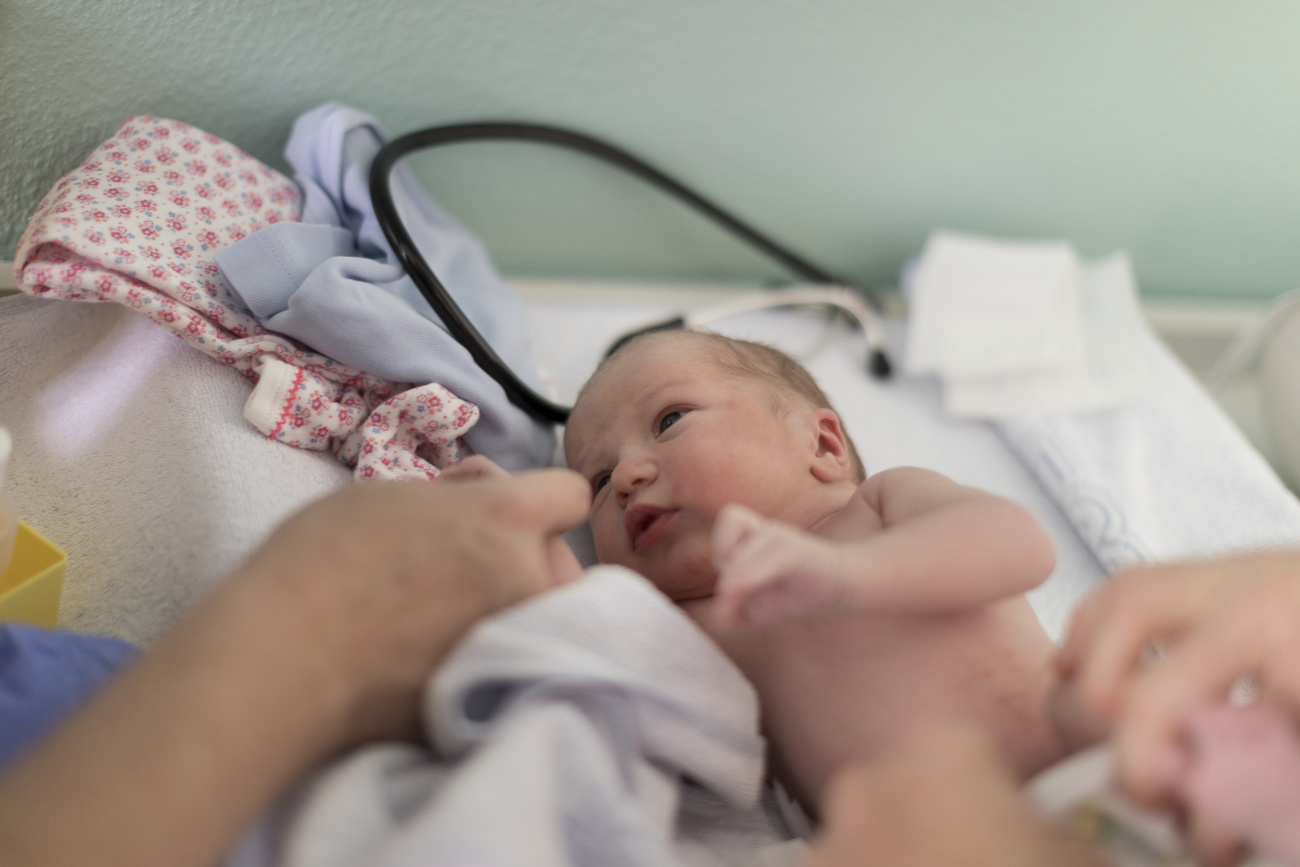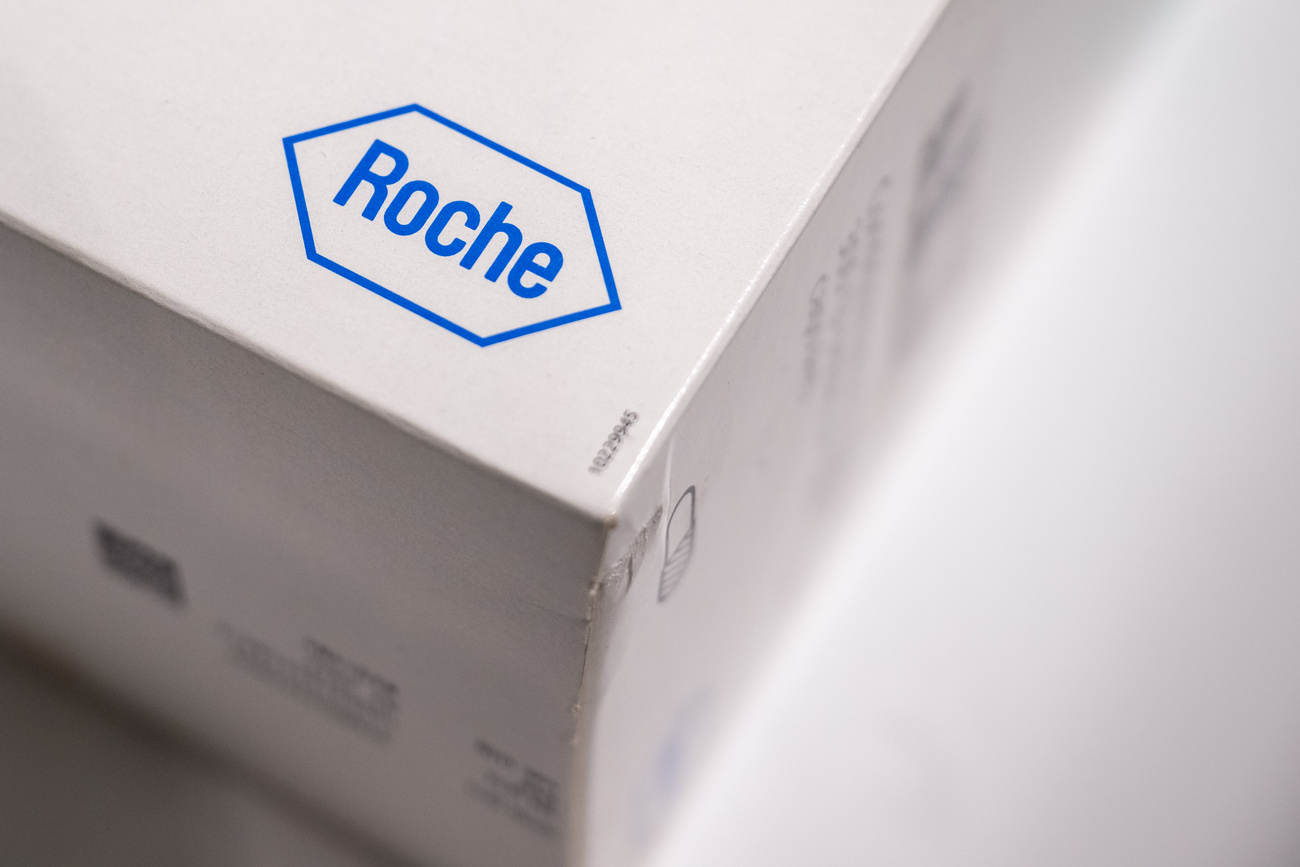
Infertility: how Switzerland is failing many couples who want a child

Infertility is a public health issue around the world. It affects about one couple in seven in Switzerland, where access to assisted reproductive technology (ART) is restricted by the high cost and legislation, which is among the strictest in Europe. Meanwhile, other countries are including ART in their family policies.
“Learning that you’re infertile is a real blow,” says Julie Rosset. “When you’ve been trying for a baby for two years, hardly thinking of anything else, and then you see women around you getting pregnant with no trouble at all, and knowing that we’ll never be able to have a child naturally, it’s really tough.”
Rosset, 37, and her husband, who live in canton Vaud, were both diagnosed as infertile. So the couple had no choice but to try in vitro fertilisation (IVF) in Lausanne. They were among the lucky ones. They have experienced the joy of having their daughter, who is now 13 months old.
It was a “long battle”, and Rosset decided to write it up on InstagramExternal link to create a support network for people in her situation. She hopes she can contribute to breaking the taboos around infertility, which people still feel ashamed of and want to hide.
Infertility is defined by the World Health Organization (WHOExternal link) as “failure to achieve a pregnancy after 12 months or more of regular unprotected sexual intercourse”. It can affect anyone, and “does not discriminate”. Nearly 18% of adults around the world – about one in six – are thought to be affected at some point.
The WHO regards this as a “major public health problem”, which can “cause significant distress, stigma and financial hardship, affecting people’s mental and psychosocial well-being”. It is also becoming an issue in society at large, due to the drop in birth rates now seen in many parts of the world.

More
Fertility rates plummet in Switzerland – and beyond
Pandemic of infertility?
There are no precise data about how many people try to have a child and fail, but it is known that infertility is one of the commonest chronic ailments of people in their child-bearing and child-rearing years.
The WHO estimates that prevalence varies from 10% to 20% depending on the region of the world. It is particularly high in East Asia and Oceania, home to some of the countries with the lowest birth-rates, such as South Korea and Japan.
In Europe, 25 million people are said to be affected. Living standards seem to make little difference, with some 18% of affected adults being found in the wealthiest countries and 16.5% in developing countries.
The trend is on the increase. Infertility has increased by 15% around the world since 1990, according to the study Global Burden of DiseaseExternal link, a standard reference work on the prevalence of various illnesses.
In Switzerland, doctors believe that about 15% of couplesExternal link are affected. The only precise figures available are for people making use of IVFExternal link, but they represent only a fraction of cases. Every year between 3,000 and 4,000 women start such a programme. In 2022, 6,600 were receiving treatment.
Parenthood after 35
“In general, it’s thought that 30% of infertility is due to the woman, 30% due to the man, 30% to both partners, and 10% where the cause is unknown,” explains gynaecologist Dorothea Wunder, who specialises in reproductive medicine.
There can be several medical issues that affect the reproductive system. According to the Federal Office of Public HealthExternal link, particular malformations or illnesses with a direct impact on fertility, such as endometriosis, are becoming more frequent. Julie Rosset was diagnosed with ovarian failure, while her husband, who is an otherwise healthy bearer of a chromosome abnormality, was found to have sperm problems. Some aspects of lifestyle, such as smoking, stress or weight problems can also affect fertility. So can exposure to endocrine disruptors, which are omnipresent in our environment.
However, the main reason for the increase in this phenomenon, doctors say, is to be found in the increasing age of mothers. A woman’s fertility declines significantly after 35 and even more after 40.
In the past 20 years, the average age of first-time mothers has increased by three years in the OECD countries from 26 to 29External link. Switzerland, one of the countries where offspring now tend to be produced the latest, is particularly affected.
Three-quarters of the women who had a baby in Switzerland in 2022 were over 30External link, and over a third were older than 35. “That is clearly having an influence,” says Wunder, noting that women are on average 37 when they apply for an IVF programme in Switzerland.
Getting into debt – just for IVF
When a couple have got an infertility diagnosis, there are certainly medical options available, and the quality of care is good here in Switzerland, Wunder says. If possible, the most “natural” approach is suggested at first, depending on the likelihood of success. “If the results of testing are indicative of this, people can start with a non-IVF approach, which means ovarian stimulation External link and/or artificial inseminationExternal link,” she explains.
But in some cases, such as with Rosset and her husband, IVFExternal link may be the only option likely to succeed. This method is not only invasive, it is also costly, because in Switzerland it’s not covered by ordinary health insurance. The insurance will pay only for the stimulation treatments and three inseminations a year, renewable in the case of a further pregnancy.
In comparison, Belgium and France, which have Europe’s most liberal policies in the matter, pay for six inseminations and six and four IVF treatments respectively up to the age of 43 for the woman.
According to Wunder, an insemination with ovarian stimulation costs about CHF1,000 ($1,100). For IVF, costs vary, but they might add up to CHF10,000. Given a success rate of no more than 20%External link per treatment cycle, several attempts are often required.
Rosset and her husband needed two attempts at IVF and three embryo transplants – along with three pre-implantation diagnoses which were not picked up by health insurance either. “We ended up spending over CHF30,000 to have our daughter,” she reckons.
The couple had to take out a bank loan, which will take them several years to pay off. “Otherwise we couldn’t have done it,” she says. “We were lucky that it worked – it doesn’t work for everybody – so it was worth doing, but ART is a complex business to begin with, and the financial burden certainly doesn’t help.”
This kind of outlay “can be prohibitive” for some people, Wunder agrees, who sees situations like that arising every day. Like other doctors, she thinks health insurance should pick up more of the tab, believing that the effectiveness criteria of the legislation are met here.
Deciding exactly what treatments will be covered by health insurance is a matter for the interior ministry, which bases its decisions on the recommendations of a commissionExternal link of healthcare specialists. For a new medical service to be added to the list, it has to receive a formal request.
Attempts by a few politicians to make ART more accessible have not convinced the majority of parliamentarians. A motionExternal link was proposed by Jean-Luc Addor of the Swiss People’s Party in 2021, but it got nowhere.
The health insurance companies just point to the extra costs which burden the healthcare system every time a new treatment is given coverage. “When it comes to IVF, we’re talking about tens of millions of francs per year at least,” says Christophe Kaempf, spokesman for the industry lobby group SantéSuisse.
ART ‘tourism’
In some cases the particular treatment needed isn’t available in Switzerland. Although the legislation on ARTExternal link has been somewhat liberalised in recent years, it is still one of the most restrictive in Europe and imposes definite conditions. It even forbids some ART approaches, notably oocyte (egg) donation.
This practice, now allowed in all European countries except Germany, is the preferred solution if infertility is due to the woman’s reproductive cells. It is more successful than IVF for those over 35, because the donors are younger. Switzerland’s parliament accepted a provision to authorise it in late 2022, but the measure will not come into force for several years.
Given this situation, many infertile Swiss couples seek ART treatments abroad. The actual number is unknown, Wunder says. Some countries, such as the Czech Republic, Denmark and above all Spain, specialise in treating people from all over Europe hoping for children.
Two of the Spanish ART centres have told SWI swissinfo.ch that they have an increasing number of patients from Switzerland. The Vida Fertility Clinic in Madrid, which serves an international clientele, sees between seven and ten Swiss patients a month, mainly for donated oocytes, says external relations manager Karine Gautron. She adds that their average age is 41.
Switzerland lags behind
The strict legislation and high costs in Switzerland meant that in 2021 the country was behind the field in the Atlas of fertility treatment policies in EuropeExternal link, established by a specialist association under the aegis of the EU. The acceptance of egg donation and the opening up of sperm donation to married female couplesExternal link will improve the rating in time, it seems.
As a onetime member of the National Advisory Commission on Biomedical EthicsExternal link, which makes recommendations on bioethical issues, Dorothea Wunder thinks the legislation could do with further modification. One example she mentions would be not requiring marriage as a condition for receiving sperm donations.
Beyond Switzerland’s borders, the idea is growing that governments should be doing something to combat infertility as part of their family policies. Asked about possible responses to the worldwide decline in birth rates, Tomas Sobotka, deputy director of the Vienna Institute of Demography, told SWI swissinfo.ch that “it’s crucial that people who need it should have access to infertility treatments”.
While recognising the need for conditions, Sobotka, who leads a Europe-wide research group on fertility and the family, believes that “governments need to be fairly generous in supporting and funding ART”.
Worried about declining birth rates in their countries, some governments seem ready to go in this direction. Japan announced in 2022 that the Japanese public health insurance system would now cover several technologies used in ARTExternal link, as have some Chinese citiesExternal link and Canadian provinces.
In January, French President Emmanuel Macron announced a national plan to overcome infertilityExternal link. This is to involve greater access to ART, better psychological care accompanying the treatments, and better awareness of issues of fertility generally.
As things are, despite an increase in the use of ART, numerous couples give up on the treatment options and resign themselves to a life without a child. “The high cost of treatments makes this unreachable for most people, especially in low- and middle-income countries,” concluded a studyExternal link that appeared at the beginning of the year in Human Reproduction UpdateExternal link.
“Access to fertility care is a major issue which disproportionately affects the basic right to start a family,” it said.
More
Edited by Samuel Jaberg. Adapted from French by Terence MacNamee/ts

More
Newsletters

More
‘Almost half of Swiss families are unable to cover an unexpected expense’

In compliance with the JTI standards
More: SWI swissinfo.ch certified by the Journalism Trust Initiative




























You can find an overview of ongoing debates with our journalists here . Please join us!
If you want to start a conversation about a topic raised in this article or want to report factual errors, email us at english@swissinfo.ch.